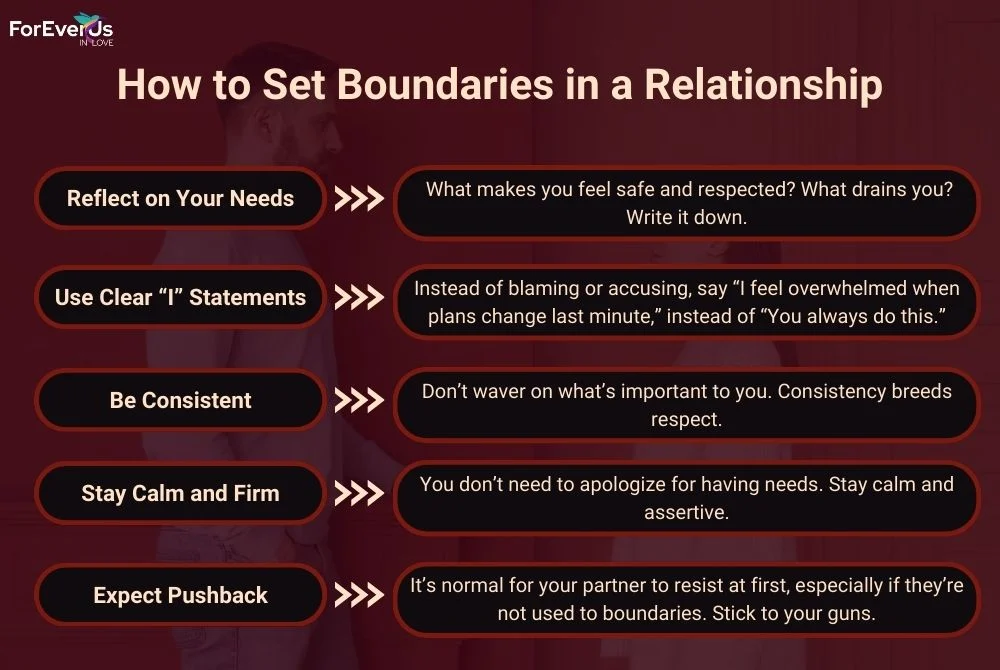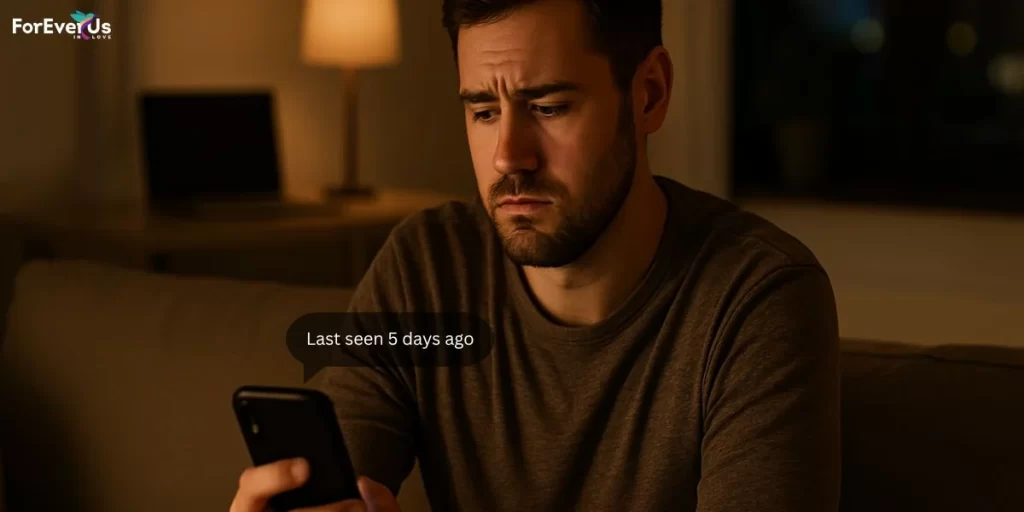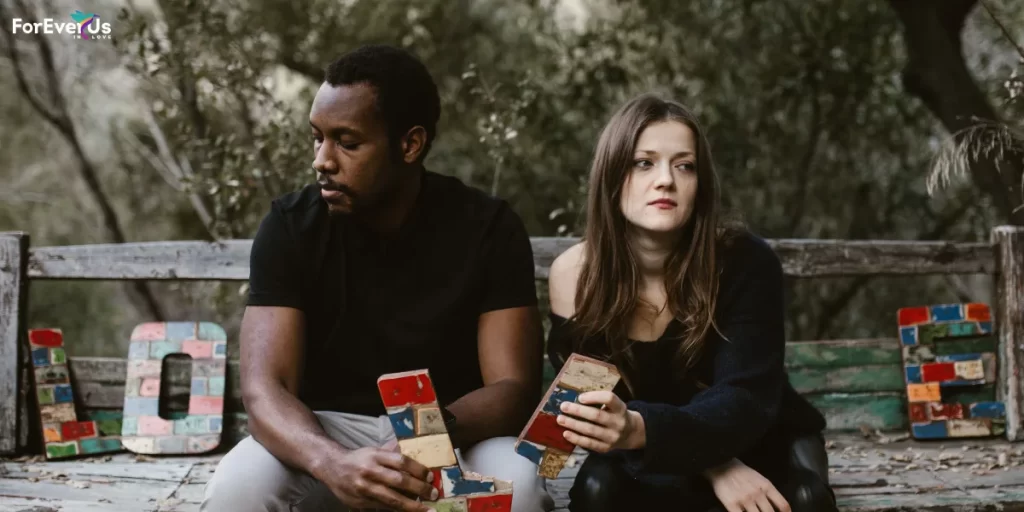Have you ever felt like you’re giving too much in a relationship and not getting enough back? Or maybe you’ve said “yes” when you wanted to say “no,” just to keep the peace?
You’re not alone — and the root of that discomfort often comes down to one simple thing: boundaries.
Boundaries in relationships aren’t walls. They’re not about shutting people out or creating emotional distance. In fact, they do the exact opposite — they protect your emotional well-being, nurture mutual respect, and allow real intimacy to thrive.
When boundaries are healthy, you feel seen, heard, and safe. When they are missing, you start to feel resentful, drained, and anxious—like you’re losing yourself.
So in this guide, we’re going to walk through:
- What boundaries actually are (and aren’t)
- Why they essential in healthy relationships
- Types of boundaries you need to know
- How to set boundaries in a relationship — without guilt
- How to recognize when your boundaries are being crossed
By the end, you’ll have a clear, practical roadmap to create a deeper connection — while still honoring yourself.
Let’s get into it.
What Are Boundaries in a Relationship?
Boundaries in relationships are the emotional, physical, mental, and even digital limits we set to define what we’re okay with — and what we’re not.
In simple terms, boundaries help people understand how to treat you.
They’re the invisible lines that say:
- “I need time to myself after work.”
- “I’m not okay with being yelled at.”
- “I value honesty, even when it’s hard.”
But here’s the truth most people don’t tell you: Boundaries aren’t about controlling others — they’re about protecting your peace.
They’re how you:
- Speak up for your needs
- Protect your time and energy
- Build self-respect and mutual respect
- Create emotional safety in your relationship
Without clear boundaries, relationships can slip into codependency, resentment, or emotional burnout. You might feel like you’re walking on eggshells or like you’re always giving without receiving.
But when are your boundaries healthy?
That’s when trust grows, communication improves, and love actually feels safe.
Why Are Boundaries Important in Relationships?
You’ve heard it before — healthy relationships need balance. But what exactly does that mean?
When boundaries are unclear or nonexistent, relationships can feel draining, one-sided, or even toxic. You might find yourself constantly bending over backward for your partner or neglecting your own needs to please them.
Here’s how setting boundaries actually improves your relationship:
- Self-Respect: You can express your true feelings and needs without guilt.
- Mutual Respect: Your partner learns how to treat you with care and consideration.
- Reduced Conflict: With clear boundaries, there’s less room for misunderstandings or hidden resentment.
- Stronger Trust: When both partners honor boundaries, trust naturally deepens.
So, if you’re feeling emotionally drained, overwhelmed, or constantly compromising, it might be time to ask yourself: Are my boundaries clear?
Emotional Safety: The Heart of Healthy Boundaries
Boundaries aren’t just about space—they’re about emotional safety. This means both partners feel secure, respected, and valued, even when navigating disagreements.
Emotional Safety Looks Like:
- Honesty without fear: Speaking openly without fear of judgment.
- Respect for “no”: “No” is heard without guilt trips or pressure.
- Validation of feelings: Emotions are acknowledged and taken seriously.
- Non-dismissal: Concerns are listened to without belittling or interrupting.
Without emotional safety, you may feel anxious, neglected, or confused. With it, you can be your true self—without fear of rejection.
Types of Boundaries in Relationships
Setting boundaries isn’t just about saying “no” — it’s about protecting your emotional, physical, and mental well-being. Let’s explore the main types of boundaries you can (and should) set in a healthy relationship — with real-life examples to help you recognize them in your own life.

1. Emotional Boundaries
These protect your right to have your own feelings, beliefs, and emotional responses — even when they’re different from your partner’s.
What this looks like:
- Saying, “I need time to process before we talk about this.”
- Protect your emotional energy by not tolerating insults, guilt-tripping, or gaslighting.
- Expressing hurt without fear of being mocked or dismissed.
Why it matters: Without emotional boundaries, you may start silencing yourself just to keep the peace.
2. Physical Boundaries
These involve your personal space, physical needs, and comfort with touch.
What this looks like:
- Asking for space when you’re overwhelmed.
- Saying, “I need a good night’s sleep, so cuddling after 30 minutes doesn’t work for me.”
- Not feeling obligated to be physically intimate if you’re not in the right headspace.
Why it matters: Physical boundaries ensure that affection and closeness come with mutual respect — not pressure.
3. Time Boundaries
These help you manage how much time you give and receive in the relationship — without burning yourself out.
What this looks like:
- “I can’t hang out tonight — I need some solo time to recharge.”
- Prioritizing work, hobbies, or family time without guilt.
- Saying “no” to plans that leave you emotionally drained.
Why it matters: Healthy love doesn’t mean constant access to each other. Space = sustainability.
4. Digital Boundaries
This involves how you interact online and what privacy looks like in the digital space.
What this looks like:
- Setting expectations on texting, social media posting, or tagging.
- Saying “I’m not comfortable sharing my passwords” — and not being guilted for it.
- Have a conversation before posting private moments.
Why it matters: Just because you’re in a relationship doesn’t mean you lose your digital autonomy.
5. Sexual Boundaries
These protect your comfort, consent, and safety in any physical or intimate activity.
What this looks like:
- Openly discussing preferences and limits without fear of judgment.
- Saying “not right now” without having to explain.
- Being respected when you say “no” or “not yet.”
Why it matters: Trust and consent are foundational to healthy intimacy. If it’s not mutual, it’s not healthy.
Examples of Healthy Boundaries in Relationships
Healthy boundaries support self-respect and emotional intelligence—not selfishness.
Examples:
- Saying “no” without guilt.
- Taking time for yourself.
- Delaying replies to messages without pressure.
- Speaking up when something feels wrong.
- Make self-care a non-negotiable.
Signs You Might Have Weak or Unhealthy Boundaries
Not sure if your boundaries need work? Watch for these red flags:
- You feel guilty when you say “no.”
- You prioritize others’ needs over your own.
- You fear upsetting people by being honest.
- You often feel emotionally drained, used, or resentful.
The good news? It’s never too late to build stronger boundaries.
How to Set Boundaries in a Relationship (Without Feeling Controlling)
Setting boundaries doesn’t mean you’re being controlling. In fact, boundaries are a sign of emotional maturity and self-awareness. When you clearly express your needs, you’re showing that you care about your well-being — and that you respect your partner enough to ask for what you need.
Here’s how to set boundaries without feeling guilty:

How to Enforce Boundaries (Even If Your Partner Pushes Back)
Let’s be real — setting a boundary is one thing. Enforcing it when someone resists? That’s where things get hard.
Many people fear:
- “Will they get mad at me?”
- “What if they pull away?”
- “Am I being too much?”
Here’s the truth: Healthy relationships can handle boundaries. If someone resists or guilt-trips you, it says more about their readiness for emotional safety than your right to express a need.
1. Start With Calm, Clear Communication
Be honest but non-blaming. Use “I” statements instead of “you always” or “you never.”
Try this:
- “I’ve realized I need more time to myself during the week. It helps me stay grounded, not disconnected from you.”
Why it works: You’re not accusing — you’re explaining your emotional needs without pressure.
2. Expect Initial Discomfort (and Stay Consistent)
Some partners may react defensively at first — especially if they’re not used to boundaries.
Try this:
“I get that this feels different, but I promise this is about keeping our relationship healthy — not pushing you away.”
If they push back repeatedly, stay consistent. Don’t water down your boundaries to avoid temporary discomfort — that’s how resentment builds.
3. If They Ignore or Test Your Boundaries
This is a red flag. Repeating yourself a few times is okay, but if they’re constantly defending your boundaries, ask yourself:
“Is this person actually listening… or trying to wear me down?”
You can say:
“I’ve expressed this boundary before. I need it to be respected, not debated.”
4. Know When to Walk Away (And When to Hold Space)
Boundaries are about protecting peace — not punishing your partner. If someone respects your limits, acknowledge and appreciate that.
But if they:
- Guilt-trip you
- Call you “too sensitive” or “dramatic”
- Constantly crossing your line without caring
Then that’s not love — it’s control.
You deserve someone who respects your no as much as your yes.
How to Communicate Boundaries Without Causing a Fight
We get it — confrontation isn’t fun, especially if you’re worried about conflict. Here’s how to approach boundary-setting without triggering an argument:
- “This helps me feel safe in our relationship.”
- “It’s not about changing you — it’s about what I need to feel okay.”
- “I’m not mad. I just want to be honest so resentment doesn’t build up.”
- “Let’s talk about this when we’re both calm. I don’t want to argue.”
Final Reminder:
You’re not selfish.
You’re not dramatic.
You’re not “too much.”
You’re allowed to take care of yourself.
The right person will want to do that with you — not against you.
What to Do When Someone Disrespects Your Boundaries
If someone consistently ignores or crosses your boundaries, it’s time to step back and assess the situation.
Here’s what you can do:
- Reinforce Calmly: “Hey, I’m not comfortable with that. Please respect this boundary.”
- State the Impact: “When you do that, I feel disrespected.”
- Set a Consequence: “If this continues, I’ll need to step back.”
Reevaluate the Relationship: If your partner refuses to respect your boundaries, ask yourself: Is this relationship still healthy?
Boundaries in Different Relationship Dynamics
Not all relationships need the same boundaries. Tailor them to the dynamic.
Different Scenarios:
- Romantic Relationships: Discuss intimacy, digital habits, time, and emotional needs.
- Friendships: Be clear on availability, venting, and emotional support.
- Family: Navigate generational differences while honoring your limits.
- Co-parenting/Ex-Partners: Keep communication respectful and child-focused.
Clarity is the cornerstone, no matter the connection.
Common Misconceptions About Boundaries
Let’s clear up a few misunderstandings:
- Myth: Boundaries mean you don’t care.
Truth: They mean you care about keeping the relationship healthy. - Myth: Boundaries are about control.
Truth: They’re about self-respect. - Myth: Saying “no” is selfish.
Truth: It’s a sign of emotional maturity and self-awareness.
Exercises and Tools to Practice Boundary Setting
Ready to build your boundary-setting? Start here:
- Boundary Checklist: List 3 things you want more of and 3 you want less of.
- Daily Journal Prompt: “Which boundary would make my day feel more balanced?”
- Role-Play: Practice saying “no” with a trusted friend or coach.
These small practices create lasting confidence.
Quick Boundary Check-In: Are Yours Healthy?
Sometimes, we don’t even realize our boundaries are being crossed — until we feel overwhelmed, exhausted, or just off. That’s why regular check-ins are so important.
Take a moment to reflect. No pressure, just honesty. Answer each with a simple Yes or No:
- Can I say “no” without feeling guilty or scared?
- Do I feel genuinely heard when I express my needs?
- Do I walk away from interactions feeling energized — or drained and resentful?
- Is my emotional, physical, and mental space consistently respected?
- Can I change my mind, ask for space, or speak up — without fear of backlash?
If you answered “No” to most of these…
It might be time to revisit your boundaries. You deserve to feel safe, valued, and respected — not just in theory, but in practice.
Boundaries aren’t selfish. They’re how we protect our peace and build stronger, healthier connections.
Ready to reset? You’ve got this.
Script: Re-establishing a Boundary After It’s Crossed
Scenario: Your partner shares something personal you asked to keep private.
“I want to talk about something that upset me. When you shared what I told you with your friend, it crossed a line for me. That was something I needed to stay between us. I need to know I can trust you with things I say in private. Moving forward, please ask before sharing anything I confide in you—even if it seems harmless.”
Conclusion
Boundaries in relationships aren’t about shutting people out — they’re about creating a space where both people feel safe, seen, and respected. Whether you’re setting boundaries for the first time or learning to redefine old ones, remember this: boundaries are an act of love — for yourself and the people you care about.
Start small. Be honest. Speak with kindness and clarity. And most of all, don’t be afraid to protect your peace.
You’re worth it.
FAQs
What are good boundaries to set in a relationship?
Communication limits, emotional needs, alone time, personal space, and digital privacy.
How can I set boundaries without feeling guilty?
Focus on your needs, speak from “I” statements, and remind yourself that boundaries are healthy, not harmful.
What if someone doesn’t respect my boundaries?
Restate it calmly, reinforce with action, and reassess the relationship if the behavior continues.












